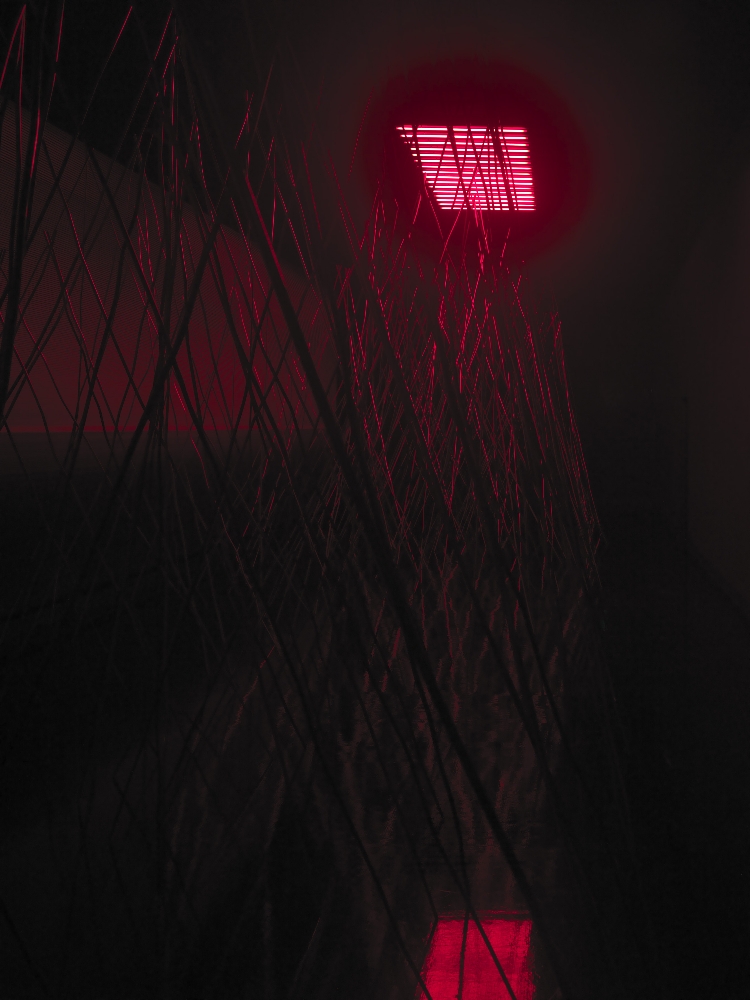
Žilvinas Kempinas, DARKROOM, 2013, Installation, dimensions variable, Courtesy of the artist and Galerija Vartai
“I enjoy creating situations within which people are confronted by something recognizable and banal, but then forget what they are actually looking at,” as the Lithuanian artist Žilvinas Kempinas has said about his work. Especially for the Kunstsammlung Nordrhein-Westfalen, Kempinas has created a new installation that allows objects and structures – now bathed in red light – to appear as images in the darkroom of an old photographer. This association alludes to a condition that is suspended between dissolution in light and materialization at a secret location. The clarity of these forms, assembled from aluminum and video strips, also evoke experiences of irritation or confusion.
Kempinas – who lives in New York City, and was born in Plungė/Lithuania in 1969 – became familiar to an international public at the latest with the Venice Biennale of 2009. Currently, the Tinguely Museum in Basel is devoting a major survey exhibition to his work. With mastery, this artist unites principles of Constructivism, Minimalism, Op Art, and Kineticism. In 2007, these qualities made him the recipient of the Calder Prize.
Kempinas has realized his most recent work, entitled DARKROOM, in situ in the Laboratory, the project room of the Kunstsammlung Nordrhein-Westfalen, as a confrontation with the proportions and other concrete characteristics of the space. DARKROOM is on view simultaneously with the exhibition Alexander Calder: Avant-Garde in Motion (Sept 07, 2013 to Jan 12, 2014) at the K20 Grabbeplatz.
Marion Ackermann, the Director of the Kunstsammlung Nordrhein-Westfalen, has juxtaposed Calder’s achievement – that of a classical modernist and co-discoverer of kinetic art – with that of a younger artist who in some of his works revisits kinetic aspects in his own way. In his new installation Kempinas invites the visitor to move between his constructions and ponder his process of perception – eventually making viewers reflect upon their relationship to the object.
A rectangular wall object – consisting of horizontally suspended strips of video tape – seems dematerialized, appears to visitors to the Laboratory as an image that resembles a landscape with horizon line.
The rectangular form and materiality of the videotape prompts a playful and theoretical confrontation with notions of the image. This wall piece is thereby suggestive of a seascape, and at the same time becomes a kind of “see-scape.”
While this portion of the installation triggers a confrontation with a specific pictorial genre, as well as with the concept of the image as such, its second part is encountered as an abstract constellation and experience. Visitors are confronted with a forest of vertical and inclined aluminum bars that generates continually new intersections as it is traversed. Despite its unequivocal materiality, the impression of points of light wandering erratically across its surface evokes associations with energetic states and movements, generating uncertainty concerning the perceptual process. In this way, Kempinas extends his investigation of the boundaries of perception through an interplay between construction and illusion, object and space, sculpture and beholder.
Sept 5, 2013 – Jan 12, 2014
Laboratory, K20 Grabbeplatz
Press Conference: Sept 5, 2013, 11 a.m.
(jointly with Alexander Calder: Avant-Garde in Motion)
Opening: Sept 4, 2013, 8 p.m. at the KPMG-Kunstabend (Art Evening)
























